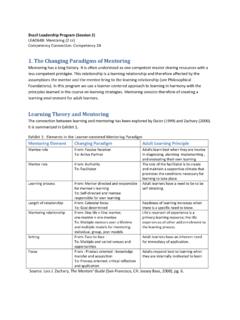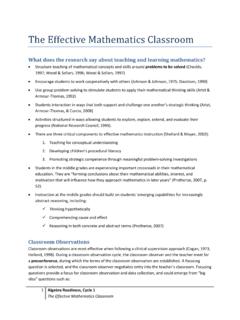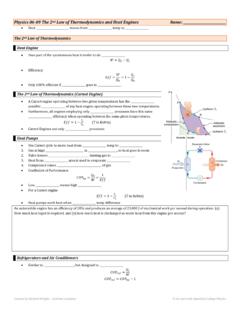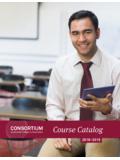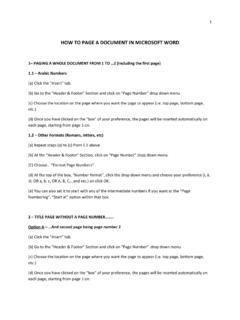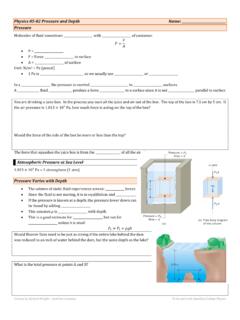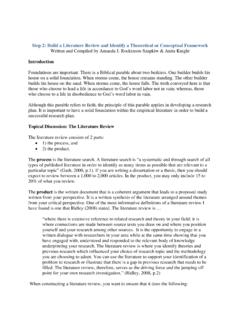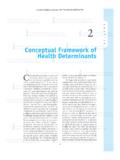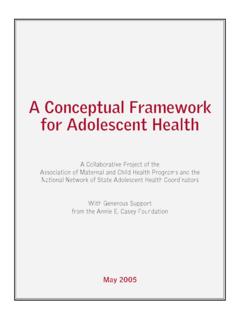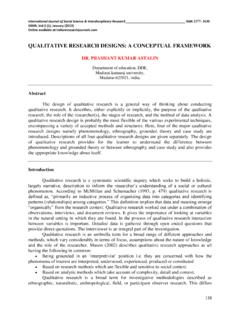Transcription of Conceptual Framework - Andrews University
1 Conceptual Framework To Educate Is to Redeem Revised 2010 James R. Jeffery, DeanSED Conceptual Framework iiConceptual Framework SED Conceptual Framework iii A Conceptual Framework establishes the shared vision for a unit s efforts in preparing educators to work in P-12 schools. It provides direction for programs, courses, teaching, candidate performance, scholarship, service, and unit accountability. The Conceptual Framework is knowledge-based, articulated, shared, coherent, consistent with the unit and/or institutional mission, and continuously evaluated. The Conceptual Framework provides the bases that describe the unit s intellectual philosophy and institutional standards, which distinguish graduates of one institution from those of another.
2 (NCATE, 2008, p. 12) SED Conceptual Framework ivTABLE OF CONTENTS INTRODUCTION .. 1 HISTORY OF THE University .. 1 THE MISSION OF Andrews University .. 1 SCHOOL OF EDUCATION HISTORY .. 2 Conceptual Framework AND MISSION .. 3 HISTORY AND DEVELOPMENT OF THE Conceptual 4 PHILOSOPHY OF THE UNIT .. 5 SIX KEY ELEMENTS OF THE Conceptual Framework .. 6 KNOWLEDGE BASE .. 7 ALIGNMENT WITH UNIT OBJECTIVES AND EXTERNAL STANDARDS .. 10 Conceptual Framework INDICATORS .. 11 Shared Vision .. 11 Coherence .. 11 Professional Dispositions .. 12 Commitment to Diversity .. 13 Commitment to Technology.
3 13 Candidate Proficiencies Aligned with Professional and State Standards .. 14 ASSESSMENT OF CANDIDATE PERFORMANCE .. 15 SUMMARY .. 15 GLOSSARY .. 16 APPENDIX A: SED Conceptual Framework IN BRIEF .. 20 APPENDIX B: Conceptual Framework REFERENCES .. 22 Conceptual Framework TO EDUCATE IS TO REDEEM INTRODUCTION Andrews University is a Christian University in the Seventh-day Adventist tradition. It encourages its students to study, practice, and develop an active religious experience. By corporate worship, community service, and a common concern for all, Andrews University students are led to develop a philosophy that makes them Christian not just in name, but in action.
4 The University is comprised of six schools/colleges: College of Arts and Sciences College of Technology School of Business Administration School of Education School of Architecture Seventh-day Adventist Theological Seminary HISTORY OF THE University The history of Andrews University began in 1874 when the Seventh-day Adventist denomination founded Battle Creek College in Battle Creek, Michigan. In 1901, the school was moved to Berrien Springs, Michigan, along the banks of the St. Joseph River and was named Emmanuel Missionary College. In 1960, Emmanuel Missionary College, the Theological Seminary, and the School of Graduate Studies united under one charter as Andrews University with an integrated board of trustees, administration, and faculty.
5 The name, Andrews University , honors John Nevins Andrews (1829-83), pioneer Adventist theologian, editor, administrator, and the denomination s first official missionary to serve outside North America. The 1,600-acre campus is located between M-139 and the St. Joseph River. It includes 27 instructional buildings, three residence halls, and three apartment complexes, as well as service and support buildings. For more history, see THE MISSION OF Andrews University The mission of Andrews is stated in these words: Andrews University , a distinctive Seventh-day Adventist Christian institution, transforms its students by educating them to seek knowledge and affirm faith in order to change the world.
6 ( ) SED Conceptual Framework 2 Accordingly, Andrews University students will: Seek knowledge as they Commit to a mindset of intellectual discovery Demonstrate the ability to think clearly and critically Communicate effectively utilizing multiple media Understand the arts, letters and sciences from a Christian point of view Become competent to serve humanity in their chosen disciplines and professions Prepare for meaningful work in a complex, technological and global society Affirm Faith as they Nurture life in the Spirit through a personal relationship with Jesus Christ Deepen their faith commitment and practice Demonstrate personal and moral integrity Embrace a wholesome way of life Respect ethnic and cultural diversity Change the World as they go forth to Cultivate the capacity for creative problem-solving and innovation Commit to generous service through civic engagement Create a caring culture of global leadership Carry out the worldwide mission of the Seventh-day Adventist church ( )
7 SCHOOL OF EDUCATION HISTORY The School of Education began as the Normal Department of Battle Creek College, established in 1874 in Battle Creek, Michigan. By 1960 the Education Department offered master s degree programs. In September 1970, Andrews University was approved by NCATE for accreditation of its elementary and secondary teacher-education programs at both the baccalaureate and master s degree levels. The North Central Association of Colleges and Schools approved the introduction of doctoral programs (1973) and granted accreditation to Andrews University as a doctoral degree-granting institution in 1979.
8 In 1981, the department reorganized into three areas: Educational Leadership and Management, Educational and Psychological Services, and Teacher Education. The following year, the PhD degree was introduced with approval of the North Central Association. In June 1983, the various undergraduate and graduate programs merged into a School of Education. The School of Education currently consists of three academic departments which are housed in Bell Hall: SED Conceptual Framework 3 Educational and Counseling Psychology (ECP) ( ) Teaching, Learning, and Curriculum (TLC) ( ) Leadership and Educational Administration (LEAD) ( ) Andrews University is accredited by the North Central Association of Colleges and Schools to confer degrees at the bachelor s, master s, specialist, and doctoral levels.
9 The teacher-preparation and school-service personnel programs, which include teacher education, curriculum and instruction, special education, and K-12 educational administration, are accredited by the National Council for the Accreditation of Teacher Education (NCATE) and approved by the Michigan Board of Education. The Council for Accreditation of Counseling and Related Educational Programs (CACREP) accredits the Community Counseling (MA) and School Counseling (MA) programs. The National Association of School Psychologists (NASP) has approved the EdS program in School Psychology.
10 Conceptual Framework AND MISSION Andrews University was founded as Battle Creek College in 1874. One of the founders, Ellen White (1903), presented a compelling vision for education. The mission of the School of Education is captured in her vision statement: True education means more than the pursual of a certain course of study. It means more than a preparation for the life that now is. It has to do with the whole being, and the whole period of existence possible to man. It is the harmonious development of the physical, mental, and spiritual powers. It prepares the student for the joy of service in this world and the higher joy of wider service in the world to In the highest sense the work of education and the work of redemption are one.

